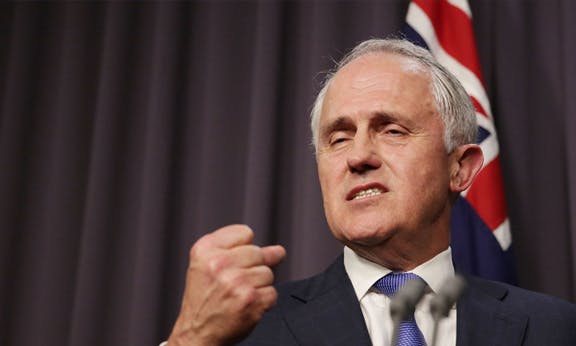The Liberal vision for Australia

Malcolm Turnbull and treasurer Scott Morrison say that their $143 billion income tax cuts will benefit us all. They are “a win for working families”, says the prime minister.
They say that the cuts will put money in our pockets – at least $530 in the next financial year for those earning less than $90,000. They say that, when the cuts come for higher income earners, there will be more jobs for the unemployed.
On top of personal income tax cuts, the Coalition wants cuts to corporate taxes by $65 billion over the next decade.
Far from being a battlers’ bonanza, the income tax cuts are aimed squarely at the affluent, the government’s voting base.
Economists at the Australian National University have done the sums. Over the next decade, the top 20 percent of income earners will receive three-quarters of the benefits – $104 billion. Once the cuts for high income earners have been implemented, that figure rises to 81 percent. Meanwhile, the bottom half of income earners get close to zero – a measly 2 percent of the benefit until 2028 and half that thereafter.
This scheme will cost the Treasury plenty – the Parliamentary Budget Office projects lost revenue of more than $24 billion a year in 2028-29. That’s money taken out of the services the government says it wants to guarantee.
The tax cuts for the well-off come on top of other lurks. Per Capita, a progressive think tank, estimates that things like the lower tax rate on superannuation contributions and earnings, income splitting between husbands and wives and negative gearing on investment properties boost the bank accounts of the top 20 percent of households by a whopping $68 billion, and just $6 billion for the bottom 20 percent.
Welfare entitlements to low income households don’t come close to evening things out. Per Capita estimates that a high income household with two children gets nearly $1,400 a week in tax concessions and government benefits. For a low income family with two children, combining disability support pension and earnings from a part time job, government support is half that – $700 a week.
A family with a small business earning more than $200,000 a year gets $1,900 in tax concessions by deducting household expenses such as a car and IT equipment and services as business costs. While the income tax cuts now being rolled out will reduce the value of these tax exemptions a little, they will do nothing to reduce their unfairness.
Once you factor in all the dodgy deals by high income individuals and business people squirreling their money away from the tax man, they are like pigs in shit thanks to the Coalition.
There is nothing job-creating or trickle down about any of this. It’s just handouts to the better-off, a windfall to those already enjoying life on the sunny side of the street.
What else could be done with this money?
Instead of handing out money to pay for private school fees and holidays in fancy hotels, let’s look at things that society would benefit from if we used the $104 billion that will go to the top 20 percent over the next decade courtesy of Morrison’s generosity.
We could put that money into a crash program of school building. With a rising school age population, we need another 750 schools to be built before 2026. That will cost state governments about $11 billion – peanuts compared to Morrison’s giveaways.
We could also improve the resources available to the education system. We could, for example, double federal funding for universities to $20 billion. Or do the same for federal funding to government schools and vocational education and still have $500 million left over.
Population growth doesn’t just mean we need more schools but more hospitals too. The construction costs of three big new hospitals in south-east Queensland completed in the last five years came to $5 billion. We could build six such hospitals every year for the next decade if the treasurer cancelled the new tax breaks for the top 20 percent. Or, to help reduce waiting times and crowding, the Treasurer could boost annual federal government outlays on public hospitals by nearly half.
We often hear about the burden of an ageing population, that pension outlays will bust the welfare budget. But Morrison’s tax cuts could boost the age pension by $4,000 every year for every one of the 2.5 million pensioners in Australia.
Pressure on disability services, both staff and clients, could be substantially alleviated if the tax cuts were scrapped. Instead of trying to patch up the irredeemably flawed National Disability Insurance Scheme, costing $17 billion this year, let’s use the $104 billion destined for the pockets of the top 20 percent over the next decade to build a world-class publicly operated system of disability services.
Or we could finally tackle poverty-level entitlements to the unemployed, students, carers and those on disability support. Ten billion dollars would be enough to increase allowances to every recipient of Newstart, Youth Allowance and Disability Support Pensions by more than $100 a week.
And then there’s housing. There are 180,000 people on social housing waiting lists across Australia. With an average cost of building new social housing at $500,000 (including land), that means we would need to devote $90 billion to house them all. That sounds like an awful lot. But it’s $14 billion less than the cost of the new income tax cuts for the top 20 percent over the next decade.
There’s no end to the worthwhile projects which Turnbull and Morrison could be funding instead of handing out the money to society’s upper echelons. But that wouldn’t be the Coalition way, which is to divert public money into the hands of those already comfortably off and away from those genuinely in need.